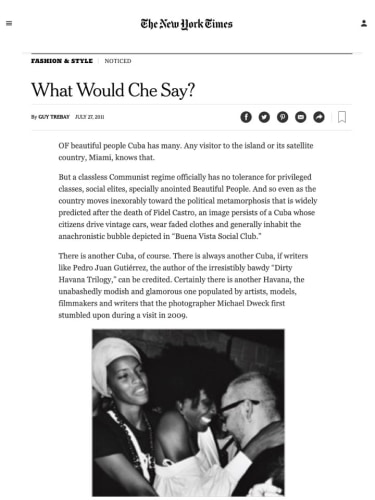What would Che say?
The New York Times
07/27/2011
Back
By Guy Trebay
OF beautiful people Cuba has many. Any visitor to the island or its satellite country, Miami, knows that.
But a classless Communist regime officially has no tolerance for privileged classes, social elites, specially anointed Beautiful People. And so even as the country moves inexorably toward the political metamorphosis that is widely predicted after the death of Fidel Castro, an image persists of a Cuba whose citizens drive vintage cars, wear faded clothes and generally inhabit the anachronistic bubble depicted in “Buena Vista Social Club.”
There is another Cuba, of course. There is always another Cuba, if writers like Pedro Juan Gutiérrez, the author of the irresistibly bawdy “Dirty Havana Trilogy,” can be credited. Certainly there is another Havana, the unabashedly modish and glamorous one populated by artists, models, filmmakers and writers that the photographer Michael Dweck first stumbled upon during a visit in 2009.
“My first night there, I met somebody who invited me to a party,” said Mr. Dweck, a former advertising executive and now a photographer, whose book “The End,” about Montauk’s surf scene, became a cult object, with copies now going for as much as $3,000.
Mr. Dweck had no clear idea whom or what kind of scene he would find at the party. “I expected all the crumbling buildings and used cars, the usual clichés,” he said.
As luck would have it, this chance introduction led him directly to the center of an exceptional group, one of the farándulas, or cliques, that characterize a certain sector of social life on the island, this one dominated by members of what Mr. Dweck calls the “privileged creative class.”
Returning to the island eight times, Mr. Dweck set about documenting these so-called new Cubans, a group of “very elegant and sophisticated and talented people” who, as it happened, included characters like Alejandro Castro Soto del Valle and Camilo Guevara, whose last names might ring a bell.
Mr. Dweck’s resulting book, “Habana Libre” (Damiani editore), can be ordered this month. “I don’t think they’d ever been photographed before” for a publication outside Cuba, he said, referring respectively to the photographer and the artist sons of Fidel and Che.
Somehow, perhaps not so mysteriously, the farándula Mr. Dweck stumbled upon has unusual access to capitalist toys and tools like iPhones, BlackBerries and Google. Its members stage regular fashion shows and cocktail parties. It transmits news of coming events with text messages using the code PMM (for “Por un Mundo Mejor,” or, essentially, “For a Better World”). It maintains an appearance about as fashionable as the one that you might expect to find across the Straits of Florida in Miami Beach, despite the reality that in Havana there are no stores. “This will be the next generation,” Mr. Dweck said. “When Cuba opens up, in a year or two.”
While the more intriguing pictures in a book shot in Mr. Dweck’s unchallenging soft-focus black-and-white style (“I didn’t want to do documentary,” he said. “National Geographic can do that”) are those depicting the sons of revolutionaries disporting themselves with models and smoking fat cigars, gotcha shots are not the sole surprise.
“Ultimately, the book is a narrative of this privileged class,” Mr. Dweck said. In its pretty, almost hapless way, the book depicts a curious warp in a great historical arc. Can it be that the end point of a violent revolution fomented to create a classless society is a crop of tropical Zoolanders and privileged “It” girls? The question, though not on the agenda of “Habana Libre,” threads through it all the same.
“Cuba has economic poverty, not human poverty,” Viviana Limpias, deputy representative of Unicef in Cuba, says in one of the interviews featured in “Habana Libre,” drawing a distinction that smacks of an earlier Cuba, the prerevolutionary one.